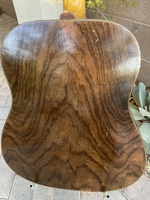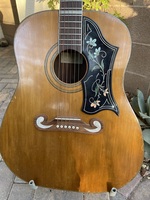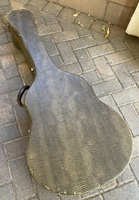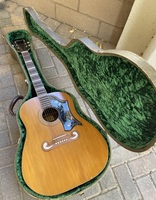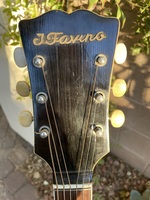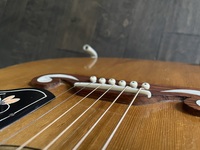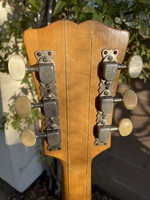For Sale
Jacques Favino: How an Italian surname became the name of some truly exceptional guitars
By Arnaud Legrand
In the 1920s, Paris became home to a large number of Italian families who sought a place to start afresh and build a decent life. This migration soon gave rise to a new activity making stringed instruments that directly competed with French luthiers in historical centres such as Mirecourt in the Vosges mountains in Eastern France.
THE HOLY TRINITY
Jacques Favino was one of these who, together with Mario Maccaferri, Bortolo Busato, Joseph Di Mauro, Pierre Anastasio and Jacques Castellucia, became a major figure among the French and Parisian luthiers who made their names in the second half of the 20th century. He was one of those who contributed to a French exception since the early 1930s, making jazz guitars that were replicas and derivatives of the jazz orchestra model originally conceived by Mario Maccaferri for the Henri Selmer Co. and made famous by the legendary Django Reinhardt.
In the mind of contemporary acoustic guitarists who follow what is broadly referred to as Gypsy music, instruments built by Selmer, Busato – who made the earliest replicas of Selmer guitars – and Favino are the top three winners, the cream of the crop, the leading triumvirate, the Holy Trinity of French guitar style – often dubbed as “guitare manouche”. Their guitars are intimately linked to the sheer brilliance of a jazz musician like Django or the peerless fluency displayed by the members of the Ferré family (father and sons). They gave voice to the musical skills of all those who paid their dues over past decades playing in smoky jazz clubs in Saint Germain des Prés or in open-air ballrooms on Bastille Days. In short, these guitars remain the tool of the trade, the absolute yardstick in gypsy and swing jazz music, and also in other typically French musical genres such as “musette”, Corsican waltzes or even North African “malouf” (from the time when Algeria was still a French colony).
A LONG APPRENTICESHIP
Jacques Favino was born in 1920 in Trecate, a small town in Piedmont in Northern Italy. He was only three when he arrived in France with his mother, who came to join her husband who had left Italy a year before in search of work. Much to his parents’ delight, the young Favino got the basic school qualification at age 12, but their poor social standing forced him to seek work as an apprentice straight away rather than further his schooling. Jacques began working in carpentry and woodworking at an early age, later reminiscing that he was taught his job in the old-fashioned way without machine tools so as to genuinely acquire the basic skills.
However, by 1936 the furniture business in France was at its lowest ebb, and the young Favino had no choice but to move to a new line of activity as a metal turner. In 1938 managed
to get a confirmed job in a company subcontracting fittings for shipyards. This new-found stability allowed him to get married the following year and to look forward to having his first child when, in late 1942, he was abruptly drafted by the occupying German troops into their mandatory labour scheme (STO in French). He was made to go and work in Germany in Nazi factories alongside thousands of other deported Frenchmen. He was not released until June 1945, and this time as a quasi-prisoner left him with a lasting distaste for factory work.
THE BUSATO ENCOUNTER
When he got back to France, Jacques Favino had a stroke of luck when his brother-in-law, Gino Papiri, arranged for him to meet Bartolo Busato (1902-1960), a guitar maker who was in need of a foreman. Busato was of Italian origin, like him, which prompted Favino to say that “he is almost family!” Although Favino had been skilled in woodworking since his teens, he knew absolutely nothing about guitar making – and in any case a guitar is hardly a piece of furniture. Humble and rational, he nonetheless embarked on a new career as an apprentice behind a workbench in order to learn his new job. At the time the Busato workshop had just moved to Cité Griset, in central Paris, and it employed about 25 people.
Jacques Favino certainly learned a great deal during his fairly short tenure with Busato, and this would later contribute to inspiring some of his own creations. He freely admits that Busato’s arch-top models as well as his Selmer replicas served as an inspiration, even if he never actually worked on them during his time at Cité Griset. More importantly, however, on both a personal and professional level, was his encounter with Jean Chauvet (1920-1981) while working for Busato. In 1946 Chauvet was a young classically trained luthier specialising in violins who had learned his trade in Mirecourt, the old-standing French Mecca of stringed-instrument making.
THE CHAUVET-FAVINO PARTNERSHIP
The two men instantly struck up a solid friendship, and Chauvet quickly suggested to Favino that they could start making their own violins at his apartment. Favino felt attracted to the inherent beauty of violin curves and intrigued by the complex alchemy underpinning violin sound. Thanks to his “old school” training in woodworking, he succeeded in delivering his first self-made violin within three months. Thus was the Chauvet-Favino partnership born. Barely six months later, in October 1946, the two partners left Busato and set up shop as independent craftsmen. Although Favino was by then totally fluent in woodworking, Chauvet played a crucial role in teaching him what he would later call the “sound of wood” and also the fastidious minutiae which befit a genuine luthier.
The instruments built at that time by Chauvet and Favino were exclusively sold to the numerous music shops on Rue de Rome in the 8th arrondissement of Paris, where the French National Conservatory of Music is located. But soon an impromptu visit by a Gypsy guitarist who needed to get his guitar mended led the two partners to enlarge their manufacturing brief. The story of Favino guitars truly began at this point in time in 1947.
The early days were not an immediate success, as the two partners had erroneously thought at first that a guitar would be much simpler to produce than a violin. Their combined expertise quickly directed them into making jazz guitars with a hand-carved top. The instruments they made in the late 1940s certainly lacked the elaborate design and flair of contemporary American instruments, but some of them actually sound remarkably good, thanks to the luthiers’ own grounding in violin making. From 1949 these guitars were branded Chauvet-Favino, at first with a red-hot iron and then with a paper label glued inside the body.
RUE DE CLIGNANCOURT
A couple of years later, as the Chauvet family had grown, Favino had to leave his partner’s apartment and look for a place of his own to install his work bench. As an interim solution he temporarily relocated in the Parisian suburb of Drancy, where he rented a former chicken barn. The set-up and location were, however, far from ideal for their business together, and by 1953 Favino and Chauvet found a suitable workshop on Rue de Clignancourt in Paris’ 18th arrondissement, near the many cabarets and night clubs of Pigalle where a lot of musicians earned their living at the time.
The Chauvet-Favino partnership continued swimmingly until 1956, when what Favino called a “little row” brought it to a premature end. The two men nonetheless parted amicably and smartly agreed that Chauvet would no longer make guitars while Favino would stay off violins. Favino was then 36, with a world of guitars ahead of him, whether for jazz or folk music. For example, he was especially keen on 12-string guitars and he became the first French maker to build what was still then a fairly unusual type of instrument. He had not yet begun to tackle Gypsy-style Selmer replicas, but as was the case in 1945 with the Busato encounter, his lucky star would soon beckon.
In the mid-1950s Favino’s output was entirely absorbed by a handful of music shops in Paris. Among these shops there was one called Pierre Beuscher (not Paul!) which in Fall 1952 had seized the opportunity of acquiring the residual inventory and guitar-related machinery of the Selmer company when the latter had decided to pull the plug on guitars. Pierre Beuscher eventually asked his supplier, Jacques Favino, to dig into this residual Selmer inventory in order to build around 20 instruments – according to Favino’s own recollection – featuring original Selmer parts. These leftover parts were essentially one-piece rosewood necks (as found on the very last Selmer guitars), tuners and tailpieces. The missing bodies had to be crafted by Favino, albeit with slightly different overall dimensions as well as a modified bracing pattern compared to an original Selmer guitar. Favino’s involvement with Selmer guitars had finally become a reality.
THE CORSICAN CONNECTION
Jacques Favino once confessed that right from day one in his career as a guitar maker, he did not think much of Selmer guitars. Both Chauvet and he had agreed that from a luthier’s perspective their construction was fairly average. On the request of a Gypsy customer in the late 1940s, he had nonetheless attempted to build a similar guitar, but as he later readily
admitted: “it did not work effectively”. So at that point he had decided not to pursue this line of instruments.
Later in the 1950s, Favino was approached by a professional guitarist of Corsican origin named Antoine Bonelli, who accompanied Tino Rossi, a famously popular Corsican crooner topping the French charts at the time. Bonelli first asked Favino to replace the damaged top of his beloved Selmer guitar, but also to build him a clone of it as a back-up instrument. Favino obliged, and by again tweaking the original bracing pattern, he built an instrument which, in his own words, “sounded like a cannon”. Perhaps more importantly, it delighted Antoine Bonelli, who instantly ordered two additional replicas after a first try. Word of mouth spreads fast among musicians, and pretty soon almost all the Corsican players at the time wanted to play a Selmer replica made by Favino – including Paolo Quilicci, the unsurpassed specialist of Corsican waltzes.
For the record, Favino made these early replicas entirely by hand as successive one-offs, rather than as part of a standard production run, even though up to three of them were sometimes made concurrently. After leaving Chauvet, Jacques Favino had hired two assistants to help him, his brother-in-law Gino Papiri and Ugo Terraneo. But he always kept certain specific jobs for himself, such as making the top and selecting the wood. In terms of the finishing process, he first used French polish before changing for gun-sprayed nitrocellulose lacquer shortly after the split with Chauvet.
GYPSY FRIENDS
The first guitarist with established Gypsy credentials to provide plenty of encouragement to Jacques Favino as a guitar builder was Pierre-Jean “Matelo” Ferré (1918-1989), one of Django’s cousins and former accompanists. The two of them first met in around 1949, and their friendship quickly blossomed to include Matelo’s sons, guitarists Boulou and Elios Ferré. A decade later, almost all the Gypsy and Manouche players from the post-WWII era, from Joseph Reinhardt to Jacques Montagne, as well as the entire Ferré family and also Maurice “Big Dog” Ferret, had gradually switched over to Favino-built Selmer-style guitars. The list of his customers, past and present, was as impressive as the talent of those who elected to play Favino’s guitars because of their unique sound.
Modernists also joined ranks with more traditional Gypsy-style jazz players. The Favino roster expanded to include players like Raphael Fays (whose father Louis was a regular visitor to the Clignancourt workshop), Biréli Lagrène, Mondine Reinhardt, Patrick Saussois, Serge Camps, Angelo Debarre and Moreno Winterstein. In Germany, Lulu Reinhardt, Hans’che Weïss, Jimmy Rosenberg and the famous Rosenberg trio arguably played their best jazz music on Favino guitars.
Favino’s soaring reputation in France during the 1960s went beyond the strict boundaries of jazz and Gypsy music. An up-and-coming singer-composer named Enrico Macias, born in Algeria and exiled to France after 1962, enjoyed tremendous popularity playing a Favino-built Selmer replica in the typically Algerian malouf style. Aspiring French folk singer Maxime Le
Forestier commissioned a bespoke 12-string flat-top from Favino meant for his American squeeze at the time, one Joan Baez! Incidentally, some say that Favino’s acoustic 12-strings are possibly among the best in the business alongside the near-mythical Guild models.
Jacques Favino once said with enlightened humility that he actually learnt his trade as a guitar maker thanks to guitarists. Although he was not himself a musician, he had an acute and efficient ear, which enabled him to constantly tailor his work with minute details so as to meet the requirements of the musicians acquiring his guitars.
BECOMING A LEGEND
Jacques Favino likes to claim that his guitars truly have a “sound of their own” – which one may like or dislike – as well as a certain type of aesthetics. His instruments are representative of his personality and of his know-how and voicing as a luthier. Some claim his guitar sound can be identified among many others as a quasi-perfect mix between power and sensitivity, with an almost frail timbre in the treble and mid-range registers clearly enhanced by a strong natural reverberation.
Today, nearly four decades after he began to hand the business to his son, Jean-Pierre, Jacques Favino is acknowledged as one of the very best makers of Selmer-style guitars. According to the man himself, his total production in this field throughout the years amounts to about 500 instruments. Each one of them carries a numbered label, duly dated and signed, sometimes with a few personal words for the patron who ordered the instrument. Throughout his career, only his better high-end models were labelled in this manner, while the bulk of his output meant for music shops did not carry any label at all.
Selmer-style Favino guitars are highly coveted today, and as demand exceeds supply, their market price has tended to soar. Regrettably, his creations in other guitar styles do not enjoy a similar level of popularity and desirability among guitarists. This is actually a shame, because all the Favino hand-built instruments are the fruit of the same passion and expertise that ultimately contribute to their soul. And this soul is what makes them all a magical joy to play!
AL. March 2017
All rights reserved. Duplication prohibited.


